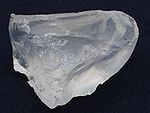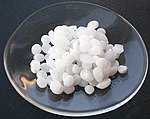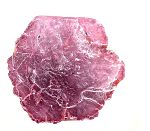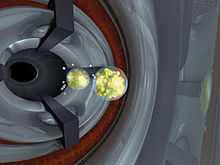The alkali metals are a group in the periodic table. In the modern IUPAC nomenclature, the alkali metals are called the Group 1 elements. The alkali metals contain lithium (Li), sodium (Na), potassium (K), rubidium (Rb), caesium or cesium (Cs) and francium (Fr).[1] (Hydrogen (H), although nominally also a member of Group 1[2], very rarely exhibits behaviour comparable to the alkali metals.) This group lies in the s-block of the periodic table. The alkali metals provide one of the best examples of group trends in properties in the periodic table, with well characterized homologous behaviour down the group.
All of the alkali metals discovered, as of 2011, are naturally occurring (although francium is the second rarest naturally occurring element - see abundance of the chemical elements for references), and share similar properties: they are all highly reactive metals under standard conditions. So far, experiments have been conducted to attempt the synthesis of the next member of the group, ununennium (Uue), but these have all met with failure. However, since ununennium is the first period 8 element and only the first element on the periodic table that has not been discovered yet, it is likely to be discovered in the near future. It is also possible that ununpentium (Uup), which has been synthesised in 2006, is the next alkali metal
Like other groups, the members of this family show patterns in its electronic configuration, especially the outermost shells, resulting in trends in chemical behaviour:
Ununennium (element 119) is likely to continue this trend, with electrons 2, 8, 18, 32, 32, 18, 8, 1, or [Uuo]8s1, but this is unconfirmed.[3]
The alkali metals are all highly reactive and are never found in elemental forms in nature. Because of this, they are usually stored in mineral oil or kerosene (paraffin oil). They also tarnish easily and have low melting points and densities.[4]
Physically, the alkali metals are mostly silver-colored, except for metallic caesium, which can have a golden tint. These elements are all soft metals of low density. Chemically, all of the alkali metals react aggressively with the halogens to form ionic salts. They all react with water to form strongly alkaline hydroxides. The vigor of reaction increases down the group. All of the atoms of alkali metals have one electron in their valence shells, hence their only way for achieving the equivalent of filled outmost electron shells is to give up one electron to an element with high electronegativity, and hence to become singly charged positive ions, i.e. cations.
The element hydrogen, with its solitary one electron per atom, is usually placed at the top of Group 1 of the periodic table for convenience, but hydrogen is not counted as an alkali metal. Under typical conditions, pure hydrogen exists as a diatomic gas consisting of two atoms per molecule.
The removal of the single electron of hydrogen requires considerably more energy than removal of the outer electron from the atoms of the alkali metals. As in the halogens, only one additional electron is required to fill in the outermost shell of the hydrogen atom, so hydrogen can in some circumstances behave like a halogen, forming the negative hydride ion. Binary compounds of hydrogen with the alkali metals and some transition metals have been produced in the laboratory, but these are only laboratory curiosities without much practical use. Under extremely high pressures and low temperatures, such as those found at the cores of the planets Jupiter and Saturn, hydrogen does become a metallic element, and it behaves like an alkali metal. (See metallic hydrogen.)
The alkali metals have the lowest ionization enthalpies in their periods of the periodic table, because the removal of their single electrons from their outmost electron shells gives them the stable electron configuration of inert gases. Another way of stating this is that they all have a high electropositivity. The "second ionization potential" of all of the alkali metals is very high, since removing any electron from an atom having a noble gas configuration is difficult to do.
All of the alkali metals are notable for their vigorous reactions with water, and these reactions become increasingly vigorous when going down their column in the periodic table towards the heaviest alkali metals, such as caesium. Their chemical reactions with water are as follows:
Alkali metal + water → Alkali metal hydroxide + hydrogen gas
For a typical example (M represents an alkali metal):
The alkali metals show a number of trends when moving down the group - for instance: decreasing electronegativity, increasing reactivity, and decreasing melting and boiling point. Their densities generally increase, with the notable exception that potassium is less dense than sodium, and the possible exception of francium being less dense than caesium (the highly radioactive element francium only exists in microscopic quantities, so its physical properties have not been measured).
Below, hydrogen is included for comparison.
†Estimation[6]
The properties, history, production, occurence, applications, biological occurences of hydrogen are all significantly different from those of the alkali metals, which is another reason why hydrogen is usually not included into the alkali metals.
Johan August Arfwedson discovered the alkali metal lithium in petalite.[8]
Humphrey Davy discovered potassium by using electrolysis on potash.[9] Davy discovered sodium a few days after potassium, by using electrolysis on sodium hydroxide.[10]
Robert Bunsen and Gustav Kirchhoff were the first to suggest finding new elements by spectrum analysis. They discovered caesium by its two blue emission lines in a sample of Dürkheim mineral water.[11] The pure metal was eventually isolated in 1882 by Carl Setterberg.[12] Bunsen and Kirchhoff discovered rubidium just a few months after caesium, by observing new spectral lines in the mineral lepidolite. Bunsen never obtained a pure sample of the metal, which was later obtained by Hervesy.[13]
Marguerite Perey discovered francium as a decay product of 227Ac.[14] Francium is the last element to be discovered in nature, rather than synthesized in the lab, although some of the "synthetic" elements that were discovered later (plutonium, neptunium, astatine) were eventually found in trace amounts in nature as well.
The next element below francium is expected to be ununennium (Uue). The synthesis of ununennium was attempted in 1985 by bombarding a target of einsteinium-254 with calcium-48 ions at the superHILAC accelerator at Berkeley, California. No atoms were identified, leading to a limiting yield of 300 nb.[15][16]

It is highly unlikely that this reaction will be useful given the extremely difficult task of making sufficient amounts of 254Es to make a large enough target to increase the sensitivity of the experiment to the required level, due to the rarity of the element, and extreme rarity of the isotope. However, given that ununennium is only the first period 8 element on the extended periodic table, it may well be discovered in the near future. Currently, none of the period 8 elements have been discovered yet. It is also possible that, due to drip instabilities, only the lower period 8 elements are physically possible. It is also possible that since ununquadium (Uuq) may have noble gas-like properties, ununpentium (Uup) may in fact be the next alkali metal. Ununpentium has already been synthesised; however, chemical experiments on it have not been carried out to verify whether it is really an alkali metal.
On February 2, 2004, synthesis of ununpentium was reported in Physical Review C by a team composed of Russian scientists at the Joint Institute for Nuclear Research in Dubna, and American scientists at the Lawrence Livermore National Laboratory.[17][18] The team reported that they bombarded americium-243 with calcium-48 ions to produce four atoms of ununpentium. These atoms, they report, decayed by emission of alpha-particles to ununtrium in approximately 100 milliseconds.
Lithium is produced via electrolysis as it would otherwise be very difficult to add an electron to the Li+ cation. Normally spodumene is used as a starting point, following which it is reacted various times, first with sulfuric acid to form lithium sulfate, then with sodium carbonate to form lithium carbonate, then with hydrogen chloride to form lithium chloride, from which pure lithium metal is extracted electrolytically.[20] Sodium is also produced via electrolysis for the same reason. As sodium chloride (table salt) is very widely available, electrolysis can simply be performed on sodium chloride to obtain pure sodium metal.[21]
Potassium is not made by the same method as the lighter alkali metals, lithium and sodium, are, as the potassium metal would be too soluble in the molten salt. Instead, potassium metal is made by reacting metallic sodium with potassium chloride at 850°C. As the potassium metal released is highly volatile, it can be removed from the system very easily.[22] Rubidium is made using a similar process as that used to make potassium, by reacting sodium metal with rubidium chloride.[23] Caesium is also made using the same process, by reacting sodium metal with caesium chloride. Again, the caesium metal released is highly volatile.[24]
Francium is vanishingly rare, being only found in trace quantities in some uranium minerals, and thus has never been isolated as the pure element. Due to its extreme radioactivity, being the most radioactive of the first 108 chemical elements (up to hassium), any amount formed would simply immediately decay to other elements.
Its parent nuclide, actinium-227, usually undergoes beta decay, but about 1% of a time undergoes alpha decay. The daughter nuclide of this reaction, once known as Actinium-K, is now recognised as francium-223, the most stable isotope of francium, with a half life of 22.0 minutes.
Francium can also be prepared artificially by bombarding thorium with protons. This transforms thorium-232 into protactinium-233, which then alpha decays into actinium-227 and francium-223.[25]
.
All of the alkali metals discovered, as of 2011, are naturally occurring (although francium is the second rarest naturally occurring element - see abundance of the chemical elements for references), and share similar properties: they are all highly reactive metals under standard conditions. So far, experiments have been conducted to attempt the synthesis of the next member of the group, ununennium (Uue), but these have all met with failure. However, since ununennium is the first period 8 element and only the first element on the periodic table that has not been discovered yet, it is likely to be discovered in the near future. It is also possible that ununpentium (Uup), which has been synthesised in 2006, is the next alkali metal
Like other groups, the members of this family show patterns in its electronic configuration, especially the outermost shells, resulting in trends in chemical behaviour:
| Z | Element | No. of electrons/shell | Electron configuration |
|---|---|---|---|
| 1 | hydrogen | 1 | 1s1 |
| 3 | lithium | 2, 1 | [He]2s1 |
| 11 | sodium | 2, 8, 1 | [Ne]3s1 |
| 19 | potassium | 2, 8, 8, 1 | [Ar]4s1 |
| 37 | rubidium | 2, 8, 18, 8, 1 | [Kr]5s1 |
| 55 | caesium | 2, 8, 18, 18, 8, 1 | [Xe]6s1 |
| 87 | francium | 2, 8, 18, 32, 18, 8, 1 | [Rn]7s1 |
The alkali metals are all highly reactive and are never found in elemental forms in nature. Because of this, they are usually stored in mineral oil or kerosene (paraffin oil). They also tarnish easily and have low melting points and densities.[4]
Physically, the alkali metals are mostly silver-colored, except for metallic caesium, which can have a golden tint. These elements are all soft metals of low density. Chemically, all of the alkali metals react aggressively with the halogens to form ionic salts. They all react with water to form strongly alkaline hydroxides. The vigor of reaction increases down the group. All of the atoms of alkali metals have one electron in their valence shells, hence their only way for achieving the equivalent of filled outmost electron shells is to give up one electron to an element with high electronegativity, and hence to become singly charged positive ions, i.e. cations.
The element hydrogen, with its solitary one electron per atom, is usually placed at the top of Group 1 of the periodic table for convenience, but hydrogen is not counted as an alkali metal. Under typical conditions, pure hydrogen exists as a diatomic gas consisting of two atoms per molecule.
The removal of the single electron of hydrogen requires considerably more energy than removal of the outer electron from the atoms of the alkali metals. As in the halogens, only one additional electron is required to fill in the outermost shell of the hydrogen atom, so hydrogen can in some circumstances behave like a halogen, forming the negative hydride ion. Binary compounds of hydrogen with the alkali metals and some transition metals have been produced in the laboratory, but these are only laboratory curiosities without much practical use. Under extremely high pressures and low temperatures, such as those found at the cores of the planets Jupiter and Saturn, hydrogen does become a metallic element, and it behaves like an alkali metal. (See metallic hydrogen.)
The alkali metals have the lowest ionization enthalpies in their periods of the periodic table, because the removal of their single electrons from their outmost electron shells gives them the stable electron configuration of inert gases. Another way of stating this is that they all have a high electropositivity. The "second ionization potential" of all of the alkali metals is very high, since removing any electron from an atom having a noble gas configuration is difficult to do.
All of the alkali metals are notable for their vigorous reactions with water, and these reactions become increasingly vigorous when going down their column in the periodic table towards the heaviest alkali metals, such as caesium. Their chemical reactions with water are as follows:
Alkali metal + water → Alkali metal hydroxide + hydrogen gas
For a typical example (M represents an alkali metal):
- 2 M (s) + 2 H2O (l) → 2 MOH (aq) + H2 (g)
[edit] Physical
When it comes to their nuclear physics, the elements potassium and rubidium are naturally weakly radioactive because they each contain a long half-life radioactive isotope. Francium is exclusively radioactive, with its most stable isotope 223Fr having a half-life of only 22.0 minutes.The alkali metals show a number of trends when moving down the group - for instance: decreasing electronegativity, increasing reactivity, and decreasing melting and boiling point. Their densities generally increase, with the notable exception that potassium is less dense than sodium, and the possible exception of francium being less dense than caesium (the highly radioactive element francium only exists in microscopic quantities, so its physical properties have not been measured).
Below, hydrogen is included for comparison.
| Group 1 element | Standard atomic weight (u) | Melting point (K) | Melting point (°C) | Boiling point (K) | Boiling point (°C) | Density (g/cm3) | Electronegativity (Pauling) |
|---|---|---|---|---|---|---|---|
| Hydrogen | 1.00794 | 14.2 | -258.8 | 20.3 | -252.7 | 0.00008988 | 2.20 |
| Lithium | 6.941 | 454 | 180.5 | 1615 | 1342 | 0.534 | 0.98 |
| Sodium | 22.990 | 370 | 97.8 | 1156 | 883 | 0.968 | 0.93 |
| Potassium | 39.098 | 336 | 63.38 | 1032 | 759 | 0.89 | 0.82 |
| Rubidium | 85.468 | 312 | 39.31 | 961 | 688 | 1.532 | 0.82 |
| Caesium | 132.905 | 301 | 28.44 | 944 | 671 | 1.93 | 0.79 |
| Francium | (223) | 300.15 | 27 | 950.15 | 677 | 1.87† | 0.70 |
[edit] Hydrogen
Main article: Hydrogen
Hydrogen is sometimes considered to be an alkali metal as it, like the other alkali metals, has one valency electron; however, hydrogen rarely acts like an alkali metal, as can be seen from the data above. In fact, it is sometimes placed over lithium (because of its s1 electron configuration and the fact that it is part of the s-block), sometimes carbon (as its electronegativity fits in that place on the periodic table) and sometimes fluorine (as it, like the halogens, can gain an electron to obtain the electron configuration of a noble gas, which is very stable).[7]The properties, history, production, occurence, applications, biological occurences of hydrogen are all significantly different from those of the alkali metals, which is another reason why hydrogen is usually not included into the alkali metals.
[edit] History
The discoveries of the alkali metals were made in very similar fashion, as shown below, except for the heaviest one, francium.Johan August Arfwedson discovered the alkali metal lithium in petalite.[8]
Humphrey Davy discovered potassium by using electrolysis on potash.[9] Davy discovered sodium a few days after potassium, by using electrolysis on sodium hydroxide.[10]
Robert Bunsen and Gustav Kirchhoff were the first to suggest finding new elements by spectrum analysis. They discovered caesium by its two blue emission lines in a sample of Dürkheim mineral water.[11] The pure metal was eventually isolated in 1882 by Carl Setterberg.[12] Bunsen and Kirchhoff discovered rubidium just a few months after caesium, by observing new spectral lines in the mineral lepidolite. Bunsen never obtained a pure sample of the metal, which was later obtained by Hervesy.[13]
Marguerite Perey discovered francium as a decay product of 227Ac.[14] Francium is the last element to be discovered in nature, rather than synthesized in the lab, although some of the "synthetic" elements that were discovered later (plutonium, neptunium, astatine) were eventually found in trace amounts in nature as well.
The next element below francium is expected to be ununennium (Uue). The synthesis of ununennium was attempted in 1985 by bombarding a target of einsteinium-254 with calcium-48 ions at the superHILAC accelerator at Berkeley, California. No atoms were identified, leading to a limiting yield of 300 nb.[15][16]

It is highly unlikely that this reaction will be useful given the extremely difficult task of making sufficient amounts of 254Es to make a large enough target to increase the sensitivity of the experiment to the required level, due to the rarity of the element, and extreme rarity of the isotope. However, given that ununennium is only the first period 8 element on the extended periodic table, it may well be discovered in the near future. Currently, none of the period 8 elements have been discovered yet. It is also possible that, due to drip instabilities, only the lower period 8 elements are physically possible. It is also possible that since ununquadium (Uuq) may have noble gas-like properties, ununpentium (Uup) may in fact be the next alkali metal. Ununpentium has already been synthesised; however, chemical experiments on it have not been carried out to verify whether it is really an alkali metal.
On February 2, 2004, synthesis of ununpentium was reported in Physical Review C by a team composed of Russian scientists at the Joint Institute for Nuclear Research in Dubna, and American scientists at the Lawrence Livermore National Laboratory.[17][18] The team reported that they bombarded americium-243 with calcium-48 ions to produce four atoms of ununpentium. These atoms, they report, decayed by emission of alpha-particles to ununtrium in approximately 100 milliseconds.
- 48 20Ca + 243 95Am → 291 115Uup* → 288 115Uup
[edit] Production
The alkali metals are usually produced using similar processes.Lithium is produced via electrolysis as it would otherwise be very difficult to add an electron to the Li+ cation. Normally spodumene is used as a starting point, following which it is reacted various times, first with sulfuric acid to form lithium sulfate, then with sodium carbonate to form lithium carbonate, then with hydrogen chloride to form lithium chloride, from which pure lithium metal is extracted electrolytically.[20] Sodium is also produced via electrolysis for the same reason. As sodium chloride (table salt) is very widely available, electrolysis can simply be performed on sodium chloride to obtain pure sodium metal.[21]
Potassium is not made by the same method as the lighter alkali metals, lithium and sodium, are, as the potassium metal would be too soluble in the molten salt. Instead, potassium metal is made by reacting metallic sodium with potassium chloride at 850°C. As the potassium metal released is highly volatile, it can be removed from the system very easily.[22] Rubidium is made using a similar process as that used to make potassium, by reacting sodium metal with rubidium chloride.[23] Caesium is also made using the same process, by reacting sodium metal with caesium chloride. Again, the caesium metal released is highly volatile.[24]
Francium is vanishingly rare, being only found in trace quantities in some uranium minerals, and thus has never been isolated as the pure element. Due to its extreme radioactivity, being the most radioactive of the first 108 chemical elements (up to hassium), any amount formed would simply immediately decay to other elements.
Its parent nuclide, actinium-227, usually undergoes beta decay, but about 1% of a time undergoes alpha decay. The daughter nuclide of this reaction, once known as Actinium-K, is now recognised as francium-223, the most stable isotope of francium, with a half life of 22.0 minutes.
Francium can also be prepared artificially by bombarding thorium with protons. This transforms thorium-232 into protactinium-233, which then alpha decays into actinium-227 and francium-223.[25]
.








0 comments:
Post a Comment